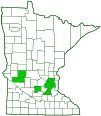Atkinson’s Fungi
(Cortinarius atkinsonianus)
Conservation • Description • Habitat • Ecology • Distribution • Taxonomy
|
|
|||||||||||||
Description |
Cortinarius is the largest genus of gilled mushrooms. There are estimated to be over 1,000 species worldwide. Cortinarius atkinsonianus, commonly known as Atkinson’s Fungi, is a common and widespread mushroom in eastern North America. It is found on the ground either scattered or growing close together (gregarious) but not in clusters. It is sometimes found in rings or arcs. It obtains its nutrients from the rootlets of living trees (mycorrhizal). It appears in the fall under or near hardwoods in deciduous and mixed forests and woodlands. The cap is 2″ to 6″in diameter. It is slimy when it first emerges from the ground. When young it is olive-yellow to yellowish and convex, and the margin is rolled inward. The surface is smooth when dry, sticky or slimy when moist. Later it may be dry but with dirt and debris stuck to the cap. As it ages the cap becomes broadly convex or flat and darkens to deep reddish-brown from the center outwards, with the margin remaining olive-yellow. The stalk 1½″ to 4¾″ tall and ⅝″ to 1¼″ in diameter at the top. When young, it has a conspicuous, abrupt, rimmed, 1¼″ to 2¾″ wide bulb at the base. As the stalk lengthens, the bulb becomes less abrupt. The stalk is solid and dry, not slimy or sticky. The color is variable, with olive-yellow or pale lavender at the top or throughout its length. The gills are closely spaced and are narrowly to broadly attached to the stalk. They do not run down the stalk. They are greenish-yellow at first, become pale lavender with yellow edges for a short time, ultimately fading to cinnamon-brown. When young, the gills are protected with a partial veil that is cobwebby or silky in texture (cortina). The cortina is greenish-yellow at first, becoming rusty-brown as it is covered with spores. When it collapses to allow the dispersal of spores, it leaves hairs on the stalk that trap the spores. The flesh is thick, firm, and whitish to pale yellow with lavender or violet areas. It stains lavender or violet when bruised. The edibility is unknown. However, many Cortinarius mushrooms are poisonous. Due to the difficulty of identifying them to the species level, it is recommended that Cortinarius mushrooms are not eaten. The spore print is rusty-brown. |
Similar Species |
Habitat and Hosts |
Deciduous forests and woodlands |
Ecology |
Season |
Fall |
Distribution |
||
|
Sources Biodiversity occurrence data published by: Minnesota Biodiversity Atlas (accessed through the Minnesota Biodiversity Atlas Portal, bellatlas.umn.edu, 6/16/2025). |
|
| 6/16/2025 | ||
Occurrence |
||
|
||
Taxonomy |
|
| Kingdom | Fungi (Fungi) |
| Subkingdom | Dikarya |
| Phylum | Basidiomycota (Basidiomycete Fungi) |
| Subphylum | Agaricomycotina (Higher Basidiomycetes) |
| Class | Agaricomycetes (Mushrooms, Bracket Fungi, Puffballs, and Allies) |
| Subclass | Agaricomycetidae |
| Order | Agaricales (Common Gilled Mushrooms and Allies) |
| Suborder | Agaricineae |
| Family | Cortinariaceae |
| Genus | Cortinarius (webcaps) |
Subordinate Taxa |
|
|
|
Synonyms |
|
|
|
Common Names |
|
Atkinson’s Fungi |
|
Glossary
Cortina
On mushrooms: A thin, silky or cobwebby veil, attached to the cap and the stalk, that protects the developing gills.
Mycorrhizal
A symbiotic, usually beneficial relationship between a fungus and the tiny rootlets of a plant, usually a tree.
Partial veil
A protective covering over the gills or pores of a developing mushroom. At maturity it disappears, collapses into a ring around the stalk, or wears away into a cobwebby covering and ring zone.
Visitor Photos |
||
Share your photo of this fungus. |
||
This button not working for you? |
||
|
||
MinnesotaSeasons.com Photos |
||
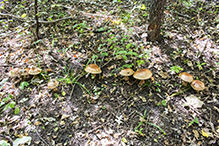 |
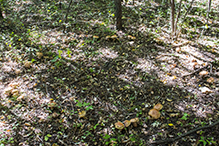 |
|
Habitat |
Fairy ring |
|
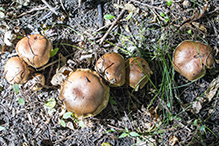 |
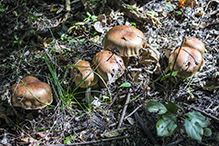 |
|
Cluster |
Cluster |
|
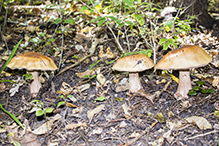 |
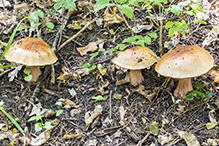 |
|
Cluster |
Cluster |
|
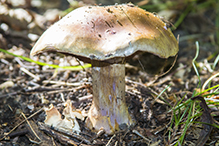 |
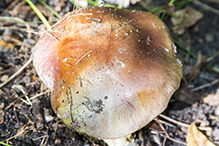 |
|
Cap |
||
|
||
|
||
Fruiting body |
|
|
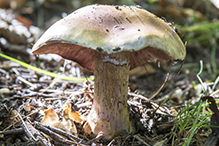 |
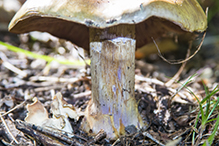 |
|
Stalk |
Stalk |
|
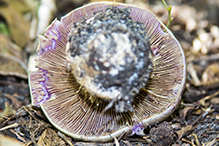 |
 |
|
Gills |
Flesh |

Slideshows |
|

Visitor Videos |
||
Share your video of this fungus. |
||
This button not working for you? |
||
|
Other Videos |
||
|

Visitor Sightings |
||
Report a sighting of this fungus. |
||
This button not working for you? |
||
|
|
MinnesotaSeasons.com Sightings |
||

Created: 3/18/2019 Last Updated: © MinnesotaSeasons.com. All rights reserved. |
